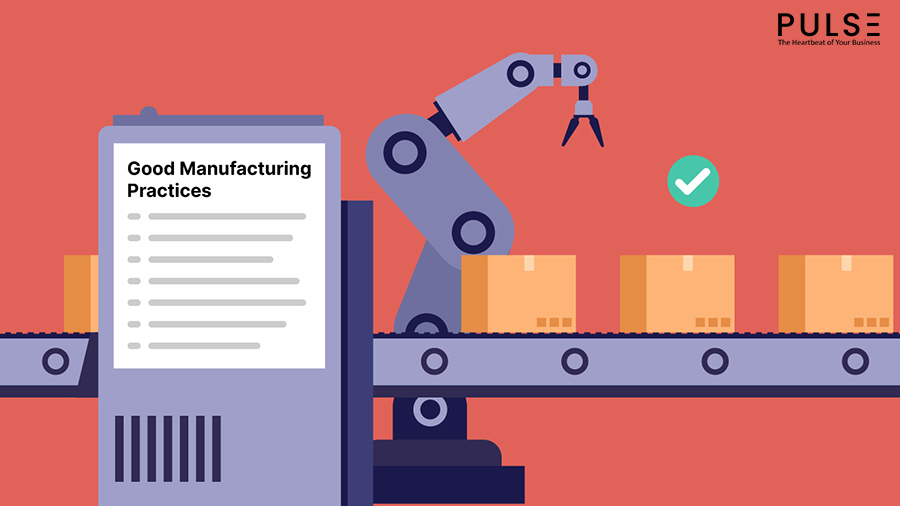GMP or Good Manufacturing Practices is a quality control system to ensure that manufacturing industries consistently produce products according to quality standards. These are a set of guidelines promulgated by the FDA to ensure the right quality and safety of produced goods. They aim to protect companies and consumers from risks involved in food, cosmetics, or pharmaceutical production.
These guidelines address various issues such as record keeping, personnel qualifications, sanitation, cleanliness, equipment verification, process validation, complaint handling, etc.
Furthermore, it gives individual manufacturers the freedom to choose how to implement the necessary controls in the most effective way for their businesses.
What is the Purpose of Good Manufacturing Practices?
Companies that adhere to GMP standards can chalk out the best processes to manufacture safe and quality goods. Here’s why Good Manufacturing Practices need to be adhered to:
- To prevent any damage caused to consumers’ health due to consumption.
- To avoid any harmful skin problems caused due to product application.
- To define and control hygiene protocols.
- To maintain facilities for improved processes and production Environment.
- To cut down the loss of money.
- To cut down the number of complaints.
- To encourage tapping on export opportunities that require GMP.
- Finally, to schedule GMP Audits to ensure compliance.
10 Principles of Good Manufacturing Practices you Should Know

A manufacturing facility producing food, packaged water, medicinal products, or even a restaurant that serves thousands must consider the basic factors for good manufacturing methods to work.
Below are the ten principles of good manufacturing practices with the intricacies of each principle.
Principle 1: Defining and creating standard operating procedures (SOPs)
This principle states creating a “road map” with written procedures for business operations. It involves preparing a set of ‘guidance documents’ that clearly defines work procedures and instructions for consistency in performance. One should also focus on creating concise and logical procedures that are easy to understand and follow.
Principle 2: Enforcing SOPs
This principle focuses on effectively following documents pertaining to work procedures. One of the significant issues involves following the documented procedures. Unfortunately, employees often use shortcut procedures that are different from those documented. Therefore, this principle encourages sticking to the established procedures and not deviating as they result in hazards.
Principle 3: Documenting work outcomes
This principle works to examine problems or complaints regarding a product. It mandates documentation of work after completion, which also enables regulatory compliance. This documentation also chronicles the exact procedures followed concerning the GMP regulations.
Principle 4: Validating the SOP’s effectiveness
Validation is an essential step to progress ahead in the process. This principle involves creating documentary evidence that the techniques, processes, and production maintain the expected level of compliance during all the stages. Using various methods to cross-check results is one of the ways to ensure confidence in the systems and processes.
Principle 5: Properly defining and designing equipment and construction facilities
Various hygienic protocols must be followed, depending on the type of product being manufactured.
This fifth GMP principle emphasizes the value of incorporating productivity, quality, and employee safety into the design and development of a company’s buildings and equipment. For example, materials, goods, and components are separated to avoid confusion, mix-ups, and errors.
Principle 6: Maintaining facilities and equipment
This principle reinforces the quality and consistency goals by enforcing proper equipment and facilities maintenance. Consumers are exposed to various risks due to a lack of equipment maintenance.
This important principle of good manufacturing practices involves maintaining a proper schedule that prevents equipment breakdown. It also aims to reduce the risks associated with product contamination and ensures that the facility or equipment is in its validated state.
Principle 7: Developing job competence
Each employee is equally invested and contributes to the manufactured product quality. Therefore, this principle states that each employee impacting the product quality should be trained. Basic GMP theory and practice, as well as role-related training, should be included in the training.
In addition, it’s also crucial to brush existing employees’ abilities with enhanced training sessions, especially as new technologies come up. Employees, as a result, should demonstrate job competency by delivering high-quality products in a safe and timely way.
Principle 8: Preventing contamination through cleanliness
Consumer protection should be at the forefront of every discussion in any production facility. This principle emphasizes the need to maintain proper cleanliness to prevent product contamination. This can be accomplished by ensuring that the workplace is cleaned daily. In addition, all cleaning and sanitization procedures must also be followed.
Principle 9: Assuring quality control
This principle entails incorporating quality directly into all production phases by putting clearly defined controls in place and preserving accurate, timely records.
Each product goes through a series of product line processes before it is called the final product. Effectively controlling each of these processes is critical to the end product’s success. Good Manufacturing, packing, labeling, distribution, and marketing are all examples of quality control.
Principle 10: Conducting planned audits
Finally, the only way to identify how successfully GMP is applied is to undertake periodic audits to evaluate the efficacy of GMP compliance. Therefore, audits must be performed regularly to ensure that nothing is overlooked.
Pulse offers world-class auditing and checklisting software-as-a-service to manufacturers to elevate production capacity and product quality.
This 360-degree audit and inspection tool can help your brand evolve with the help of carefully created manufacturing checklists. Pulse empowers your teams by conducting frequent hassle-free inspections for safety, health, risks, quality, machinery, equipment, compliance, and much more.
Register now for a free trial of the digital inspection process. You can also call us at 1800-266-9988 to speak with one of our representatives!
